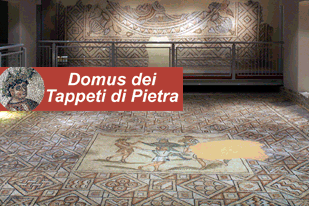Theodoric, the great Germanic king





Theodoric, the great Germanic king, in Ravenna. Hotels next to the Byzantine basilicas in the historical down town of Ravenna.
Photo: 1)the Mausoleum of Theodoric, 2)The roof of the Mausoleum,3)the Palace so called of Theodoric, 4)the Arian Baptistery and Cathedral, the Church of the Holy Spirit, 5)the Palace so called of Theodoric, at the background the campanile of S.Apollinare Nuovo,
The third spotlight now falls on king Theodoric.
With the fall of the Western Roman Empire, Ravenna became the capital of an immense area under siege.
Odoacer, the general who ousted the last emperor, soon found himself in a totally different role going from “Roman Aristocrat“ to usurper under siege in the impenetrable Ravenna.
After no less than three years of siege to the walls of Classe Theodoric succeeded in entering Ravenna by sea; and destroyed him in the manner learnt in Byzantium: by poisoning.
The town wall is still there, captured in the mosaic by Saint Apollinare Nuovo, the mental projection of a exhausted and starved artist as Ravenna resisted to the last.
Theodoric remained in Ravenna for thirty years: in 502 he repaired the aqueduct of Traiano, he extended the Royal Palace with the splendid adjoining palatal chapel (which is now Sant’Apollinare Nuovo), the Cathedral (which is now the Church of the Holy Spirit) and the Arian Baptistery.
Finally he built his mausoleum, which was as mysterious and overwhelming as an Egyptian pyramid: the roof being a single giant mass weighing 200-300 tons, which was perhaps transported on a raft pushed over the marshes and lagoons of the Po.
Traces of the cult of Arian heresy still remain in the form of the only existing monuments; but religious disputes, even under the iron hand of the Goth King, continued unabated even in the world of art.
So that the Catholic Bishop Peter ll, segregated in the Bishopric decorates his private oratory with a warrior Jesus that treads on the serpent and Arian lion and a flock of birds of a surprising variation of colours and natural likeness.
On the same wall he wrote that immortal phrase on the light, the soul of the mosaic that is still able to amaze the visitor today.
Theodoric the “Germanic” died in 526 and as always on the death of a great historic figure the blend of intrigue and rancour once again rose to the surface. Queen Amalasunta was assassinated in 535, the daughter of Theodoric, a brave and able woman with the only defect of not being Arian but a catholic.
Prof. Gianni Morelli
The pleasure of fine accommodation in the centre of Ravenna: we recommend the Fabbri hotels for a pleasant stay as follows:
The Centrale Byron hotel, 3-star hotel in the centre of Ravenna;
The Hotel Bisanzio, 4-star hotel in the centre of Ravenna;
Once you have reached the hotel and parked your car, forget it and walk everywhere, because everything is within walking distance.
The railway station is near our hotels and within walking distance.
© reserved copyright





